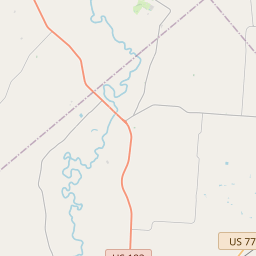Von Hugo-Von Clausewitz Family Cemetery
Historical marker location:






(1,000 feet south) The nearby oak grove served as a family cemetery from the 1870s, originally for two Prussian families immigrating to Texas in the 1850s. They sailed to the port of Indianola and settled here, close to Hochheim Prairie (3 miles west).
Carl Ottomar Gunther Theodor Von Hugo (1805-1875) originally owned the property; his is the oldest marked grave in the cemetery. He was born in Prussia and married Albertine Amalie Elise Elenore, Countess Zu Dohna (1813-1890), also a Prussian native.
Gustav Adolph Frederick Von Clausewitz (1802-1874) owned the land adjacent to the cemetery. He was born at Berg, Prussia, and his passport for immigration was dated 1858. He married Elise Elenore Wilhelmine, Countess Zu Dohna (1817-1870), sister of Albertine Von Hugo. Both Von Clausewitz graves are now unmarked but are recorded in the family cemetery.
The cemetery has some 14 known graves, and possibly others from before the turn of the century. Other family names represented in the cemetery by record are Barth, Bulwer, Nelson, Petering, and Stablefeld.
Burials ceased evidently after the completion of nearby St. Ann's Church in 1906 and the location there of a church cemetery.
Texas Sesquicentennial 1836-1986
As one of the most visible programs of the Texas Historical Commission (THC), historical markers commemorate diverse topics in Texas history, including: the history and architecture of houses, commercial and public buildings, religious congregations, and military sites; events that changed the course of local and state history; and individuals who have made lasting contributions to the state, community organizations, and businesses.
The city of Austin, the state capital, is known as the live music capital of the world. It is home to many music festivals, including South by Southwest (SXSW) and the Austin City Limits Music Festival.
In 1827, the area that is now DeWitt County was incorporated into the Mexican state of Coahuila y Tejas. Shortly after, American settlement began in the region, with empresarios such as Green DeWitt and Martín de León playing significant roles. DeWitt, for whom the county is named, received a land grant in 1825 and played a vital part in bringing Anglo-American colonizers to the area.
DeWitt County saw significant growth during the Texas Revolution in the 1830s. The Battle of Gonzales, the first engagement of the revolution, occurred just outside the county's boundaries. The county itself became a site of conflict during the revolution, with the Battle of Ethel's Woods and the Battle of Gonzales River Bridge taking place within its borders.
After Texas gained independence from Mexico, DeWitt County was officially established in 1846. The county seat was initially Gonzales, but it was moved to Cuero in 1876. Throughout the late 19th and early 20th centuries, DeWitt County experienced economic growth due to industries such as ranching, oil, and agriculture.
Present-day DeWitt County continues to thrive as a center for agriculture, oil and gas production, and tourism. The county is known for its rich historical sites, including the Gonzales Memorial Museum, which houses artifacts from the Texas Revolution, and numerous ranches that showcase the area's strong cattle industry. DeWitt County's history is a testament to the resilience and determination of its early settlers and remains an essential part of Texas's broader historical narrative.
DeWitt County Timeline
This timeline provides a concise overview of the key events in the history of DeWitt County, Texas.
- 1827: DeWitt County is established as a part of DeWitt's Colony in Mexican Texas.
- 1840: The Battle of Plum Creek takes place in DeWitt County during the Texan Revolution.
- 1846: DeWitt County becomes a part of the newly formed Republic of Texas.
- 1848: Texas becomes a state of the United States, and DeWitt County remains a part of it.
- 1850: Population growth leads to the establishment of the county seat, Cuero.
- 1870: The Gulf, Western Texas and Pacific Railway reaches Cuero, increasing trade and transportation opportunities.
- 1874: Cuero is officially incorporated as a city.
- 1893: Oil is discovered in DeWitt County, leading to economic growth and development.
- 1923: A disastrous fire destroys much of downtown Cuero.
- 1941-1945: DeWitt County contributes to the war effort during World War II.
- 1960s-1970s: DeWitt County experiences a decline in population and economic activity.
- 1990s-present: DeWitt County experiences a resurgence in oil and gas production, leading to economic growth.